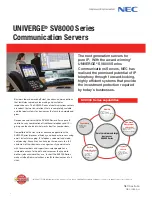
Colorspace
– this control is used to define the colorspace of the input video signal. Choices include:
YUV
(709),
RGB (709)
and
CAP XYZ
. This setting is particularly useful when recording JPEG2000 image formats where the
source is not in the required CAP XYZ colorspace. If the Input Colorspace is YUV (709) or RGB (709), the Acuity
will automatically convert that colorspace to CAP XYZ as it records JPEG2000 formats.
Input
Colorspace
Encoding
Recorded
Colorspace
Output
Colorspace
YUV (709)
QPE
YUV (709)
YUV (709)
YUV (709)
QPE
RGB (709)
RGB (709)
YUV (709)
JPEG2000
DCP
CAP XYZ
RGB (709)
QPE
RGB (709)
RGB (709)
RGB (709)
QPE
YUV (709)
YUV (709)
RGB (709)
JPEG2000
DCP XYZ
CAP XYZ
CAP XYZ
JPEG2000
DCP XYZ
CAP XYZ
CAP XYZ
JPEG2000
DCP XYZ
P3 RGB (TI)
CAP XYZ
QPE/JPEG2000
YUV (709)
YUV (709)
CAP XYZ
QPE/JPEG2000
RGB (709)
RGB (709)
Output Colorspace Conversion options are available (see Play Video menu page options in the Acuity user manual)
during playback in order to convert from CAP XYZ to YUV (709) or RGB (709 or P3). These output colorspace
conversion options allow Digital Cinema JPEG2000 content to be previewed on display devices that do not natively
support the CAP XYZ colorspace.
Destination
– this control is used to specify the volume and directory location (destination path) where recorded
assets will be stored. A volume, in QuVIS terminology, is a set of one (1) or more hard drives that effectively serves
as a single storage device.
Note:
There may be limit to your ability to record high-quality, high frame rate material depending upon the
number of disks that make up the destination volume. The minimum number of drives in a volume is
generally determined by the
Maximum Data Rate
(MDR) setting. General guidelines are as follows:
MDR30 = 2-drive volume (recommended)
MDR60 = 2-drive volume (required)
JPEG2000 250Mbit/sec = 2-drive volume (required)
Maximum Data Rate
– this control is is used to set the maximum data rate of the recorded clip. For JPEG2000
formats this value should be set to 250Mbits/sec in order to ensure compliance with Digital Cinema requirements.
For a description of MDR settings for QPE content recording, refer to the QuVIS Acuity User Manual.
Encoding
- this control is used to specify which type of image compression (encoding) will be used. To record
JPEG2000 content, set this value to “JPEG2000”. For a description of the QPE encoding options, refer to the
QuVIS Acuity User Manual.
Clip Form (Record Video Adv 2/5
menu page) – for DCI JPEG2000 projects, this value should be set to
“Expanded clip (editable)”. If this value is set to the factory default value “Collapsed Clip (non-editable)” the resulting
clip (video and audio essence) cannot be used as a VTP track asset.
Real-time JPEG2000 Record – Audio Input Settings
Proper audio settings are important when recording a JPEG2000 clip especially if the audio tracks recorded will be used
as track assets with a DCP project. If the JPEG2000 clip is to be used as part of a Digital Cinema Package, then there
are certain audio settings that are required to ensure proper DCI compliance.
QuVIS Acuity
™
Page 104
QSR Version 3.3
Содержание Acuity
Страница 1: ......
Страница 152: ...Keyboard Hotkeys Description ENTER Complete current edit QuVIS Acuity Page 151 QSR Version 3 3...
Страница 190: ...QuVIS Acuity Page 189 QSR Version 3 1...
Страница 200: ......
















































